2011 85th KOKUFU BONSAI EXHIBITION
+16
xuan le
Kev Bailey
Karl Thier
bigbabol
Todd Ellis
Ryan
kauaibonsai
Rob Kempinski
Paul Landis
craigw
sunip
Russell Coker
bontailo
Billy M. Rhodes
Ravi Kiran
William N. Valavanis
20 posters
Page 1 of 2
Page 1 of 2 • 1, 2 
 2011 85th KOKUFU BONSAI EXHIBITION
2011 85th KOKUFU BONSAI EXHIBITION
The 85th Kokufu Bonsai Exhibition opened on Sunday, February 13, 2011 in the new temporary location in Asakusa, across the street from the Asakusa Kannon Temple in the Tokyo Metropolitan Industrial Trade Center. A great tourist stop.
The exhibition is all in one room, on the 7th floor. It must have been an ordeal to move over 250 bonsai and display tables in elevators all the way up to the 7th floor. Many new sections of backgrounds needed to be purchased in order to use the new venue, very expensive, as is the daily rental for the 7th floor.
In the past the bonsai were displayed in four rooms which allowed one to mentally rest between studying the bonsai. Also, there were areas where one could stop, sit and think before moving on. This year all the bonsai are in one room, no time to sit and think. Difficult to study. Overload! Even for me! Can’t take it all in and appreciate the beauty. The ceiling was low which also created an intimate feeling, but I personally preferred the high ceiling of the Art Museum.
This year 346 bonsai were entered for judging and 245 were accepted. The number of entries decreased slightly as owners did not want their prize bonsai displayed in the Industrial Trade Centered, they preferred the Art Museum.
There were an additional 8 special displays which brought the total display areas up to 253. There were only 9 shohin bonsai compositions, which is less than in the past. So if you count the individual bonsai in the shohin bonsai compositions and also there were many three point medium size bonsai, there are well over 300 boensai on display.
Attendance the r day was 2,400. Yesterday, Monday only 1,000 people attended. Don’t know about today’s attendance, I’ll find out tomorrow. Vendors were apprehensive about buyers, but the Green Club sales area was crowded the first day. Last night there was quite a bit of snow which hit the sale hard. Remember, many of the sales areas are outdoors.
There were five “National” or Kokufu Awards: Japanese flowering Apricot, Sargents Juniper, Ezo Spruce, Korean Hornbeam and a Japanese Five-needle Pine (it also won the Prime Minister Award at November’s Taikan Ten Exhibition, must be a good tree). Doug Paul, from the Kennett Collection in Pennsylvania also had a beautiful Sargents juniper on display, which will be coming to the US soon.
There were a great number of Ezo spruce on display and also medium size bonsai too.
I’ll probably find more interesting facts after tomorrow’s study.
Bill
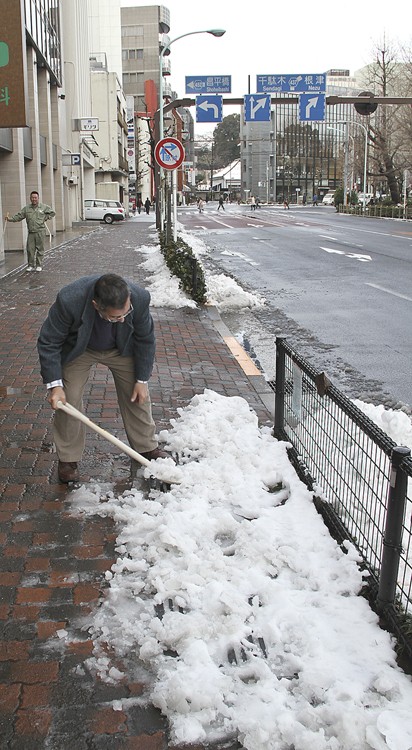
I'm experienced at shoveling snow...
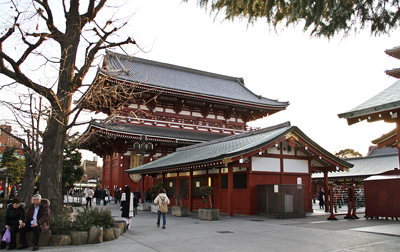
Asakusa Kannon Temple across the street from Kokufu Bonsai Exhibition
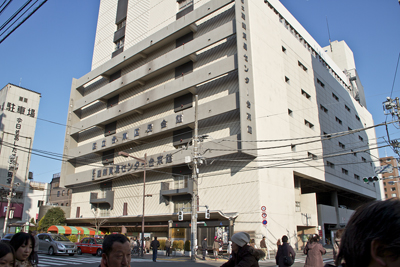
Kokufu Bonsai Exhibiton on 7th floor
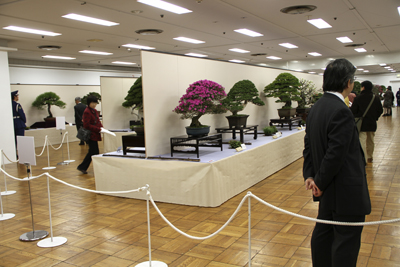
Exhibition View
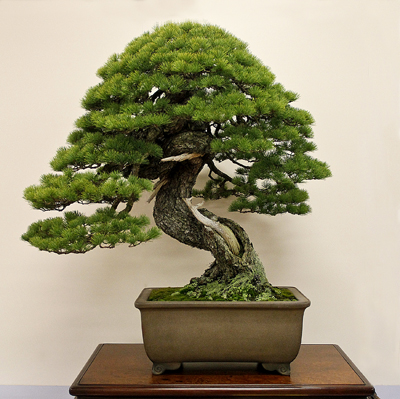
Japanese five-needle pine National Award winner, it also received the Prime Minister Award at the Taikan Ten Exhibition in November 2010.
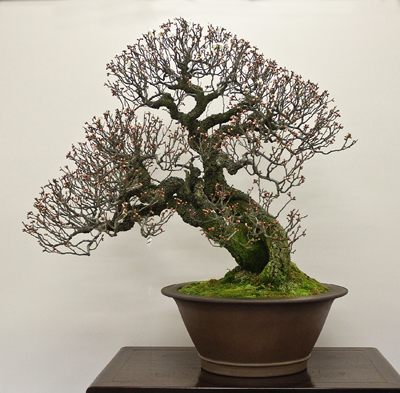
Japanese flowering apricot National Award winner.
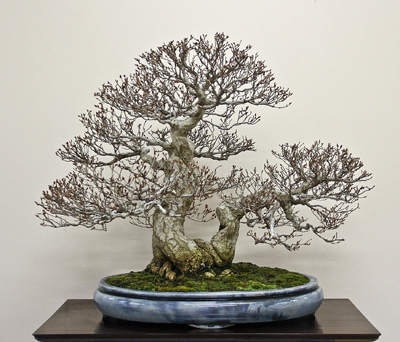
Korean hornbeam National Award winner.
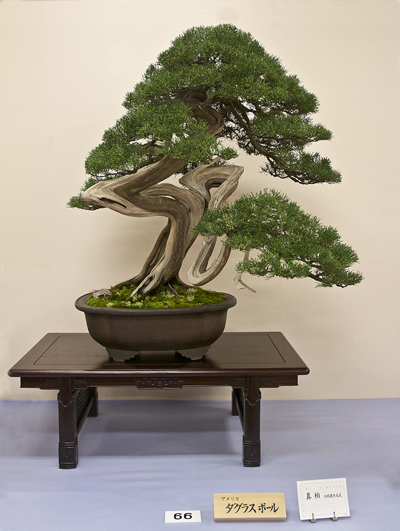
Sargents juniper displayed by Doug Paul, Pennsylvania.
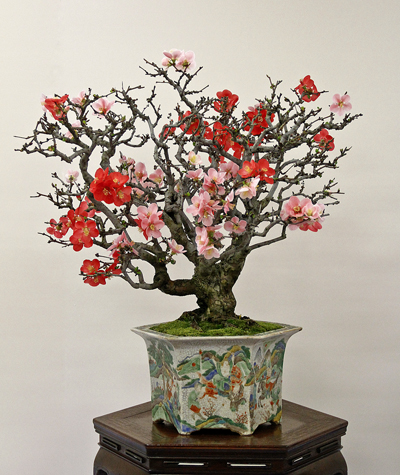
An unusual cultivar of Japanese flowering quince. This is NOT the Toyo Nishiki cultivar, but rather 'Takane Nishiki'. Beautiful flowers, unusual container, but I personally do not like the design of the bonsai, so enjoyed the blossoms,
The exhibition is all in one room, on the 7th floor. It must have been an ordeal to move over 250 bonsai and display tables in elevators all the way up to the 7th floor. Many new sections of backgrounds needed to be purchased in order to use the new venue, very expensive, as is the daily rental for the 7th floor.
In the past the bonsai were displayed in four rooms which allowed one to mentally rest between studying the bonsai. Also, there were areas where one could stop, sit and think before moving on. This year all the bonsai are in one room, no time to sit and think. Difficult to study. Overload! Even for me! Can’t take it all in and appreciate the beauty. The ceiling was low which also created an intimate feeling, but I personally preferred the high ceiling of the Art Museum.
This year 346 bonsai were entered for judging and 245 were accepted. The number of entries decreased slightly as owners did not want their prize bonsai displayed in the Industrial Trade Centered, they preferred the Art Museum.
There were an additional 8 special displays which brought the total display areas up to 253. There were only 9 shohin bonsai compositions, which is less than in the past. So if you count the individual bonsai in the shohin bonsai compositions and also there were many three point medium size bonsai, there are well over 300 boensai on display.
Attendance the r day was 2,400. Yesterday, Monday only 1,000 people attended. Don’t know about today’s attendance, I’ll find out tomorrow. Vendors were apprehensive about buyers, but the Green Club sales area was crowded the first day. Last night there was quite a bit of snow which hit the sale hard. Remember, many of the sales areas are outdoors.
There were five “National” or Kokufu Awards: Japanese flowering Apricot, Sargents Juniper, Ezo Spruce, Korean Hornbeam and a Japanese Five-needle Pine (it also won the Prime Minister Award at November’s Taikan Ten Exhibition, must be a good tree). Doug Paul, from the Kennett Collection in Pennsylvania also had a beautiful Sargents juniper on display, which will be coming to the US soon.
There were a great number of Ezo spruce on display and also medium size bonsai too.
I’ll probably find more interesting facts after tomorrow’s study.
Bill

I'm experienced at shoveling snow...

Asakusa Kannon Temple across the street from Kokufu Bonsai Exhibition

Kokufu Bonsai Exhibiton on 7th floor

Exhibition View

Japanese five-needle pine National Award winner, it also received the Prime Minister Award at the Taikan Ten Exhibition in November 2010.

Japanese flowering apricot National Award winner.

Korean hornbeam National Award winner.

Sargents juniper displayed by Doug Paul, Pennsylvania.

An unusual cultivar of Japanese flowering quince. This is NOT the Toyo Nishiki cultivar, but rather 'Takane Nishiki'. Beautiful flowers, unusual container, but I personally do not like the design of the bonsai, so enjoyed the blossoms,
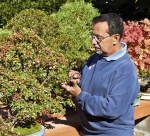
William N. Valavanis- Member
 Re: 2011 85th KOKUFU BONSAI EXHIBITION
Re: 2011 85th KOKUFU BONSAI EXHIBITION
Dear Will,
Thanks a lot for posting... Nice to get a first hand report from Kokufu.... Do post as many pics of the exhibited trees as you could. Shall be very grateful for that as that is the next best thing to being there.... Thanks again....
Ravi
Thanks a lot for posting... Nice to get a first hand report from Kokufu.... Do post as many pics of the exhibited trees as you could. Shall be very grateful for that as that is the next best thing to being there.... Thanks again....
Ravi

Ravi Kiran- Member
 Re: 2011 85th KOKUFU BONSAI EXHIBITION
Re: 2011 85th KOKUFU BONSAI EXHIBITION
Wish I was there, but. Interesting that a flowering tree, the apricot, won an award without flowers or fruit and in an unglazed pot. It is a great tree, but.
Does the tree exhibited by the American live in Japan?
How many Americans have had trees shown.
Does the tree exhibited by the American live in Japan?
How many Americans have had trees shown.

Billy M. Rhodes- Member
 Re: 2011 85th KOKUFU BONSAI EXHIBITION
Re: 2011 85th KOKUFU BONSAI EXHIBITION
The Japanese flowering apricot, as well as the Magnolia, Winter flowering Cherries, Winterhazels and more are normally displayed in bud. In a couple of days they will be in full blossom.
Generally speaking high quality flowering bonsai are NOT planted in glazed containers. In fact, there were many Satsuki azaleas displayed and I don't remember any of them in glazed pots.
I believe Doug Paul was the first America to display at the Kokufu Bonsai Exhibition, that was last year. This Sargents juniper was collected, trained and prepared for this exhibit for over two years and will be coming to the US soon.
Bill
Generally speaking high quality flowering bonsai are NOT planted in glazed containers. In fact, there were many Satsuki azaleas displayed and I don't remember any of them in glazed pots.
I believe Doug Paul was the first America to display at the Kokufu Bonsai Exhibition, that was last year. This Sargents juniper was collected, trained and prepared for this exhibit for over two years and will be coming to the US soon.
Bill

William N. Valavanis- Member
 Re: 2011 85th KOKUFU BONSAI EXHIBITION
Re: 2011 85th KOKUFU BONSAI EXHIBITION
Bill,
Thanks for post.
Have a nice trip in Japan.
Thanks for post.
Have a nice trip in Japan.

bontailo- Member
 Re: 2011 85th KOKUFU BONSAI EXHIBITION
Re: 2011 85th KOKUFU BONSAI EXHIBITION
Thanks .. and interesting with the flowering apricot (as mentioned) because we just had a view on why deciduous/flowering trees "always" are shown in glazed/coloured pots and conifers in earth coloured unglazed pots. (In another thread).
So as mentioned, it may be more tradition and taste than a rigid "rule".
Regards
Morten
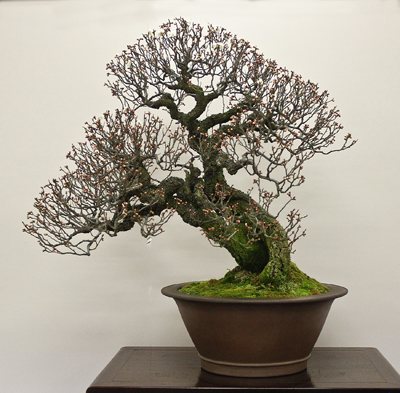
So as mentioned, it may be more tradition and taste than a rigid "rule".
Regards
Morten

Guest- Guest
 Re: 2011 85th KOKUFU BONSAI EXHIBITION
Re: 2011 85th KOKUFU BONSAI EXHIBITION
Hi Bill.
I'm really glad Mr. Paul likes to spend his money on bonsai rather than cars. I like the juniper, especially the natural color of the bark and dead wood. Looks better than that rich brown/shocking white treatment they usually get, imo.
What's the bonsai with the magenta colored flowers in the exhibit shot - bougainvillea?
Hope your feet are ok!
R
I'm really glad Mr. Paul likes to spend his money on bonsai rather than cars. I like the juniper, especially the natural color of the bark and dead wood. Looks better than that rich brown/shocking white treatment they usually get, imo.
What's the bonsai with the magenta colored flowers in the exhibit shot - bougainvillea?
Hope your feet are ok!
R

Russell Coker- Member
 Re: 2011 85th KOKUFU BONSAI EXHIBITION
Re: 2011 85th KOKUFU BONSAI EXHIBITION
Hi William N. Navalis,
I love how that beautiful high pot from the award winning five needle pine gives the tree an upward breathe (lift).
In the overview picture i see the surprising movement of the pine, i loved to peek into the crown of that tree.
I imagine the Japanese love that flowering quince.
Since you have permission to take pictures at the Kokofu, you can imagine we long for more,
of course also one of the apricot in a few days.
Many tanks.
Regards, Sunip
I love how that beautiful high pot from the award winning five needle pine gives the tree an upward breathe (lift).
In the overview picture i see the surprising movement of the pine, i loved to peek into the crown of that tree.
I imagine the Japanese love that flowering quince.
Since you have permission to take pictures at the Kokofu, you can imagine we long for more,
of course also one of the apricot in a few days.
Many tanks.
Regards, Sunip
sunip- Member
 Re: 2011 85th KOKUFU BONSAI EXHIBITION
Re: 2011 85th KOKUFU BONSAI EXHIBITION
Thanks for showing us these amazing trees. That apricot has the most incredible ramification for this species.
Craig
Craig
craigw- Member
 Re: 2011 85th KOKUFU BONSAI EXHIBITION
Re: 2011 85th KOKUFU BONSAI EXHIBITION
Morten,
Yes, selecting the container for bonsai depends primarily on taste and tradition, there are no "rules", (except for outside of Japan by people who believe they know more than the Japanese do).
It is important to know when the bonsai will be displayed and enjoyed. For example for this Kokufu Bonsai Exhibit, which is now held in winter (did you see the snow!) the structure of the Satsuki will be displayed. So, they are planted in unglazed, antique Chinese containers, to avoid drawing attention from the design of the bonsai.
When the Kokufu Bonsai Exhibition began in 1934 it was held twice a year (Spring and Autumn) until about 1948 when they began to hold the exhibition in Winter (December-February). Probably many of the deciduous species used glazed containers to highlight the autumn changing of the foliage colors.
Another important fact to remember is that this is a "bonsai" exhibition. Until about 20 years ago Satsuki azaleas were not considered bonsai, but rather as "Satsuki" and they had their own exhibitions held in late spring so they could show off their beautiful colorings. The important display item here was flowers, not form, so the design was compromised to show off the flowers. There were some strange shapes then because they needed to design plants which had room to display the flowers properly. Those exhibitions were to introduce new Satsuki azalea cultivars so people would buy them at high prices. When the market was saturated with a new cultivar, they hybridized new cultivars to make money. Remember, here bonsai is business (used to be big) and primarily not a hobby.
But now, the training techniques have vastly improved and there are beautiful Satsuki azaleas displayed at Kokufu Bonsai Exhibition without flowers so unglazed expensive containers are used. In fact, if you were to visit Kunio Kobayshi (Shunka-en Bonsai Garden in Tokyo) in December and January he had a tremendous number of antique Chinese containers available for rent. The bonsai would be transplanted into the new containers so they would be accepted at the judging, held in January, for the exhibition held now.
Ryan Neil traveled to Japan in January to help his teacher, Masahiko Kimura transplant all the bonsai he was showing for his clients into their "exhibition containers". Even the most beautiful bonsai in the world would not be accepted into this exhibition if it were in an inexpensive pot. After the exhibition the bonsai are transplanted into their normal containers. Sometimes they owners like the new pots and eventually purchase them which makes Kobayashi very happy.
Doug Paul, Kennett Collection in Pennsylvania, last year displayed his Japanese hemlock at the Kofufu Bonsai Exhibition. He loves American and European containers and most of his bonsai collection are in beautiful quality containers made by Westerners. He wanted to send an American pot to Japan for his bonsai last year. He was told that if his bonsai was in an American pot it would not be accepted at the judging.
Sometimes if a flowering bonsai has a good design and can be enjoyed all year around it might be shown in an unglazed container which is good all the time. If the flowering bonsai is only enjoyed when in blossom, it is often planted in a glazed container which looks good when in the tree is in color, but not at other times of the year.
There are no "rules" for bonsai in Japan, and the selection of containers is a deep subject which depends on taste, season, exhibition and of course your pocketbook.
Bill
Yes, selecting the container for bonsai depends primarily on taste and tradition, there are no "rules", (except for outside of Japan by people who believe they know more than the Japanese do).
It is important to know when the bonsai will be displayed and enjoyed. For example for this Kokufu Bonsai Exhibit, which is now held in winter (did you see the snow!) the structure of the Satsuki will be displayed. So, they are planted in unglazed, antique Chinese containers, to avoid drawing attention from the design of the bonsai.
When the Kokufu Bonsai Exhibition began in 1934 it was held twice a year (Spring and Autumn) until about 1948 when they began to hold the exhibition in Winter (December-February). Probably many of the deciduous species used glazed containers to highlight the autumn changing of the foliage colors.
Another important fact to remember is that this is a "bonsai" exhibition. Until about 20 years ago Satsuki azaleas were not considered bonsai, but rather as "Satsuki" and they had their own exhibitions held in late spring so they could show off their beautiful colorings. The important display item here was flowers, not form, so the design was compromised to show off the flowers. There were some strange shapes then because they needed to design plants which had room to display the flowers properly. Those exhibitions were to introduce new Satsuki azalea cultivars so people would buy them at high prices. When the market was saturated with a new cultivar, they hybridized new cultivars to make money. Remember, here bonsai is business (used to be big) and primarily not a hobby.
But now, the training techniques have vastly improved and there are beautiful Satsuki azaleas displayed at Kokufu Bonsai Exhibition without flowers so unglazed expensive containers are used. In fact, if you were to visit Kunio Kobayshi (Shunka-en Bonsai Garden in Tokyo) in December and January he had a tremendous number of antique Chinese containers available for rent. The bonsai would be transplanted into the new containers so they would be accepted at the judging, held in January, for the exhibition held now.
Ryan Neil traveled to Japan in January to help his teacher, Masahiko Kimura transplant all the bonsai he was showing for his clients into their "exhibition containers". Even the most beautiful bonsai in the world would not be accepted into this exhibition if it were in an inexpensive pot. After the exhibition the bonsai are transplanted into their normal containers. Sometimes they owners like the new pots and eventually purchase them which makes Kobayashi very happy.
Doug Paul, Kennett Collection in Pennsylvania, last year displayed his Japanese hemlock at the Kofufu Bonsai Exhibition. He loves American and European containers and most of his bonsai collection are in beautiful quality containers made by Westerners. He wanted to send an American pot to Japan for his bonsai last year. He was told that if his bonsai was in an American pot it would not be accepted at the judging.
Sometimes if a flowering bonsai has a good design and can be enjoyed all year around it might be shown in an unglazed container which is good all the time. If the flowering bonsai is only enjoyed when in blossom, it is often planted in a glazed container which looks good when in the tree is in color, but not at other times of the year.
There are no "rules" for bonsai in Japan, and the selection of containers is a deep subject which depends on taste, season, exhibition and of course your pocketbook.
Bill

William N. Valavanis- Member
 Re: 2011 85th KOKUFU BONSAI EXHIBITION
Re: 2011 85th KOKUFU BONSAI EXHIBITION
Thanks for the detailed reply Bill. Great information!!!

Paul Landis- Member
 Re: 2011 85th KOKUFU BONSAI EXHIBITION
Re: 2011 85th KOKUFU BONSAI EXHIBITION
Dear Bill
Thanks for a detailed insight and well explained too. I appreciate much.
Hope you enjoy every minute of the tour.
Best regards
Morten Albek
Thanks for a detailed insight and well explained too. I appreciate much.
Hope you enjoy every minute of the tour.
Best regards
Morten Albek
Guest- Guest
 Re: 2011 85th KOKUFU BONSAI EXHIBITION
Re: 2011 85th KOKUFU BONSAI EXHIBITION
Morten,
Glad you enjoyed my message.
I did NOT enjoy shoveling snow, I can do that at home from November to May.
Bill
Glad you enjoyed my message.
I did NOT enjoy shoveling snow, I can do that at home from November to May.
Bill

William N. Valavanis- Member
 Re: 2011 85th KOKUFU BONSAI EXHIBITION
Re: 2011 85th KOKUFU BONSAI EXHIBITION
William N. Valavanis wrote:Morten,
Glad you enjoyed my message.
I did NOT enjoy shoveling snow, I can do that at home from November to May.
Bill
Two winters in a row with low temp. and loads of snow. Zone envy? Yes!
I wait to the summer to do my next Japan trip (without that fluffy white stuff coming down)
Regards
Morten
Guest- Guest
 Re: 2011 85th KOKUFU BONSAI EXHIBITION
Re: 2011 85th KOKUFU BONSAI EXHIBITION
Very informative William. Thank you for explaining especially the no "rules" on pot.
but, like you said 'if the pot were in American pot it will not be selected", why is that so?
regards,
jun
but, like you said 'if the pot were in American pot it will not be selected", why is that so?
regards,
jun
Guest- Guest
 Re: 2011 85th KOKUFU BONSAI EXHIBITION
Re: 2011 85th KOKUFU BONSAI EXHIBITION
Jun,
The Japanese plant old respected bonsai in old antique pots. A younger bonsai might be planted in a "new" or contemporary pot, while the masterpieces are always planted in appropriate containers. The American containers have no "history" or are new. Age is highly respected and selecting the appropriate quality container is equally important as to selecting the suitable shape, size and color.
Respect for the bonsai is most important in Japan. Only the highest quality containers are utilized in the Kokufu Bonsai Exhibition which have antiquity and patina. I've never seen a brand new Japanese container used in this show, it would not be appropriate.
If the American (or Western) container were over 150 years old and showed patina, even with a few chips, sometimes filled with gold, it might be accepted.
Bill
The Japanese plant old respected bonsai in old antique pots. A younger bonsai might be planted in a "new" or contemporary pot, while the masterpieces are always planted in appropriate containers. The American containers have no "history" or are new. Age is highly respected and selecting the appropriate quality container is equally important as to selecting the suitable shape, size and color.
Respect for the bonsai is most important in Japan. Only the highest quality containers are utilized in the Kokufu Bonsai Exhibition which have antiquity and patina. I've never seen a brand new Japanese container used in this show, it would not be appropriate.
If the American (or Western) container were over 150 years old and showed patina, even with a few chips, sometimes filled with gold, it might be accepted.
Bill

William N. Valavanis- Member
 Re: 2011 85th KOKUFU BONSAI EXHIBITION
Re: 2011 85th KOKUFU BONSAI EXHIBITION
Thanks for the report Bill,
Always fantastic trees.
Too bad about the snow hurting the event.
Always fantastic trees.
Too bad about the snow hurting the event.

Rob Kempinski- Member
 Re: 2011 85th KOKUFU BONSAI EXHIBITION
Re: 2011 85th KOKUFU BONSAI EXHIBITION
Very clear now.
So that's where the rentals of antique pots comes in.
thank you again.
regards,
jun
So that's where the rentals of antique pots comes in.
thank you again.
regards,
jun
Guest- Guest
 Re: 2011 85th KOKUFU BONSAI EXHIBITION
Re: 2011 85th KOKUFU BONSAI EXHIBITION
thanks bill,
yours is always the first peek at kokufu.
best wishes, sam
yours is always the first peek at kokufu.
best wishes, sam
kauaibonsai- Member
 Re: 2011 85th KOKUFU BONSAI EXHIBITION
Re: 2011 85th KOKUFU BONSAI EXHIBITION
Hey Bill,
Beautiful trees and appears to be a great show. I don't mean to hijack the thread, but that Sargents Juniper by Doug Paul makes me wonder. These questions are for anyone, really, but how does one get a tree from Pennsylvania all the way to a place like that? How many precautions must be used on a tree that fragile (looking) and large? Thanks!
Beautiful trees and appears to be a great show. I don't mean to hijack the thread, but that Sargents Juniper by Doug Paul makes me wonder. These questions are for anyone, really, but how does one get a tree from Pennsylvania all the way to a place like that? How many precautions must be used on a tree that fragile (looking) and large? Thanks!
Ryan- Member
 Re: 2011 85th KOKUFU BONSAI EXHIBITION
Re: 2011 85th KOKUFU BONSAI EXHIBITION
Bill, Thank you for posting the pictures and your explanations of "why things are the way they are" at the Kokufu.
I look forward to seeing you at the Symposium in Lynchburg on February 26th.
Best, Todd
I look forward to seeing you at the Symposium in Lynchburg on February 26th.
Best, Todd
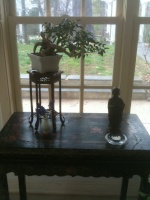
Todd Ellis- Member
 Re: 2011 85th KOKUFU BONSAI EXHIBITION
Re: 2011 85th KOKUFU BONSAI EXHIBITION
hello ryan: I believe mr paul purchased the juniper from a supplier in Japan. before the tree is sent to the U.S. and two years of quarantine, his agent submitted the tree for entry at kokufu and got the tree accepted for showing. the same process occurred last year with his hemlock.
best wishes, sam
best wishes, sam
kauaibonsai- Member
 Re: 2011 85th KOKUFU BONSAI EXHIBITION
Re: 2011 85th KOKUFU BONSAI EXHIBITION
thank for sharing, please post continuously 
rgds
bigbabol
rgds
bigbabol

bigbabol- Member
 Re: 2011 85th KOKUFU BONSAI EXHIBITION
Re: 2011 85th KOKUFU BONSAI EXHIBITION
If you see the pictures of the Kokufu trees, then my trees are very cheap and I know that I am removed light years from this quality. 

Thanks William for your comments and images.
Thanks William for your comments and images.
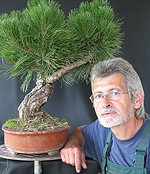
Karl Thier- Member
 Re: 2011 85th KOKUFU BONSAI EXHIBITION
Re: 2011 85th KOKUFU BONSAI EXHIBITION
Thanks Bill for your photo's and details. I hope that the rest of your trip this year is as enjoyable with not too much more snow.
I am pleased to note that the move to this 7th floor display area is a temporary one. I thought the Art Museum an excellent display space. Is it being refurbished?
I am pleased to note that the move to this 7th floor display area is a temporary one. I thought the Art Museum an excellent display space. Is it being refurbished?

Kev Bailey- Admin
Page 1 of 2 • 1, 2 
 Similar topics
Similar topics» 2013 87th KOKUFU BONSAI EXHIBITION
» 2012 KOKUFU BONSAI EXHIBITION REPORT
» Exhibition of bonsai in Moscow, May 28-June 5, 2011
» NATIONAL BONSAI & SUISEKI EXHIBITION 2011 IN JAKARTA
» Suzdal (Russia) Bonsai and Suiseki exhibition 2011
» 2012 KOKUFU BONSAI EXHIBITION REPORT
» Exhibition of bonsai in Moscow, May 28-June 5, 2011
» NATIONAL BONSAI & SUISEKI EXHIBITION 2011 IN JAKARTA
» Suzdal (Russia) Bonsai and Suiseki exhibition 2011
Page 1 of 2
Permissions in this forum:
You cannot reply to topics in this forum






